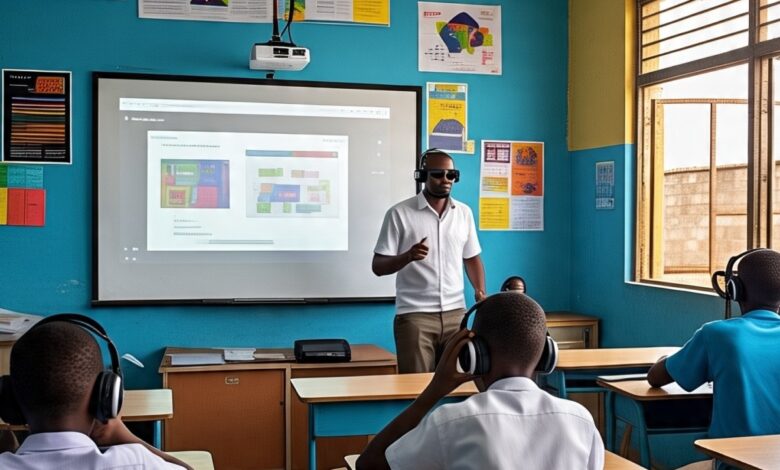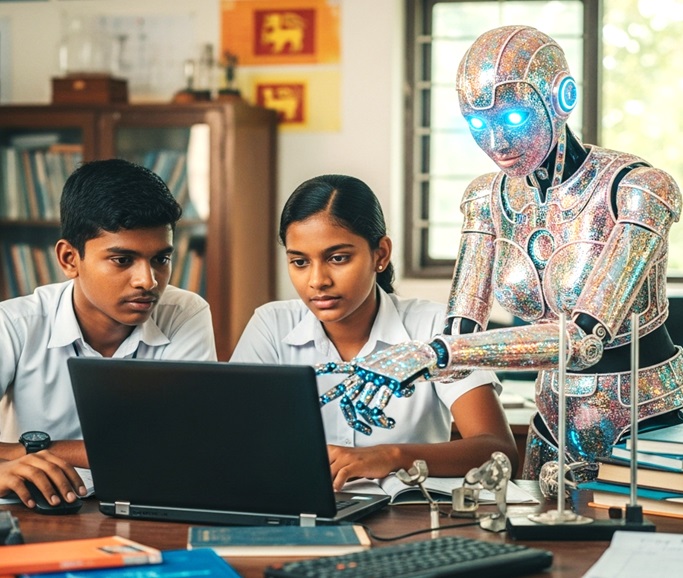AI Revolution in Sri Lankan Education: From Classrooms to Campuses
Dr. Mahinda Alahakoon, Associate Professor, NSBM Green University

The halls of Sri Lanka’s educational institutions—from rural primary schools to the nation’s premier universities are echoing with a new buzzword: Artificial Intelligence, or AI for short. As the world stands at the precipice of what experts call the “Fourth Education Revolution,” Sri Lanka faces both unprecedented opportunities and complex challenges in integrating AI across its education system at various stages, from K12 and even up to the university level.
“The nations that will thrive in the coming decades are those that learn to make AI an ally in education, not just a tool,” recently remarked Professor Saman Halgamuge of the University of Melbourne, a distinguished Sri Lankan expatriate. His words resonate deeply as Sri Lanka navigates this transformative era.
The AI Classroom: A New Era of Personalized Learning
In primary and secondary education, AI is transforming traditional teaching environments and techniques at a speed never experienced before. Imagine a future where every student has a tailor-made learning journey. Adaptive learning platforms, drawing inspiration from global pioneers like India’s BYJU’S and China’s Squirrel AI, are making this a reality (please see the table for a sample collection of such AI resources). These intelligent systems constantly analyze student responses, pinpointing knowledge gaps and dynamically adjusting content difficulty in real-time. For Sri Lanka, grappling with a significant 23% vacancy rate for STEM teachers in rural schools as revealed by a 2021 Education Ministry report, such technologies could be a game-changer, offering invaluable solutions to the persistent shortage of trained educators.
| Learning Platform | Where Launched | Main Features | Target Audience |
| BYJU’S | India (Global) | AI-driven personalized paths, video lessons, competitive exam prep (JEE/NEET) | K-12, STEM aspirants |
| Khan Academy | USA (Global) | Free adaptive exercises, progress dashboards, teacher tools | K-12, college foundations |
| Squirrel AI | China | Real-time knowledge gap detection, 1:1 AI tutoring | K-12 after-school students |
| DreamBox Learning | USA (Global) | Game-based math, adjusts difficulty dynamically | Elementary-middle school math |
| ALEKS | USA (Global) | AI assessments, mastery-based STEM modules (math/chemistry) | High school & university STEM |
| Duolingo | USA (Global) | Adaptive language lessons, gamified rewards, speech recognition | Language learners (all ages) |
| Century Tech | UK (Global) | Combines neuroscience and AI, reduces teacher workload | K-12 schools, corporate training |
| Smart Sparrow | Australia/USA | Customizable virtual labs, adaptive simulations | University STEM, medical schools |
| Cognii | USA | AI grading for essays, NLP-based feedback | K-12 & higher-ed (writing focus) |
| Querium | USA | Step-by-step STEM coaching, career skill-building | Adult learners, STEM professionals |
Some adaptive learning platforms
The potential extends beyond academic instruction. AI-driven language tools could revolutionize English language training and adaptation—a persistent challenge in Sri Lankan schools. Imagine a Sinhala-medium student in Angunakolapalassa receiving instant, AI-powered translations and pronunciation guidance while studying science textbooks originally written in English. Similarly, AI grading systems could alleviate the burden on overworked teachers, freeing up valuable time for individualized student attention.
Though it is true that students are getting their grip on some AI resources to support their tasks, proper and adequate guidance to use the available resources in the proper manner to enhance their learning is minimal. Further, access to adaptive learning environments is very rare in the country.
STEM Education: AI as Both Tool and Subject

The integration of AI in STEM (Science, Technology, Engineering, and Mathematics) education presents particularly compelling possibilities. In engineering education, AI-powered simulation tools are enabling students to experiment with complex concepts in virtual environments. At NSBM Green University, an AI-powered lab monitoring system developed by students now manages safety protocols and energy use—demonstrating how Sri Lankan institutions can innovate with limited resources. Such homegrown solutions could inspire broader AI integration across the country’s education sector.
For mathematics education, AI tutors can provide infinite patience and customized problem sets—addressing what many educators identify as a critical bottleneck in Sri Lanka’s STEM-related teaching and learning process. The Sri Lanka Institute of Nanotechnology (SLINTEC) has begun collaborating with international partners to develop AI tools that can guide students through complex chemistry experiments, potentially overcoming resource limitations in school laboratories.
However, this technological promise comes with some drawbacks as well. Over-reliance on AI problem-solving tools risks creating a generation of students strong in executing solutions but weak in conceptual understanding—a particular danger in foundational engineering education. As educators at the university level, many have observed a decline in students’ analytical ability and independent problem-solving skills—probably due to the degradation of well-structured formal school education, which has been replaced by ad hoc tuition culture. Being overly dependent on AI tools may aggravate the situation if proper guidance and initiatives are not implemented well in advance.
The AI-Enhanced University: Research and Administration
In higher education, AI’s impact is perhaps most profound. At the University of Peradeniya, computer science researchers are using AI algorithms to accelerate data analysis in agricultural studies, processing what would previously have taken months in mere days. The University of Colombo’s medical faculty has begun experimenting with AI diagnostic assistants, though ethical concerns about patient data privacy remain unresolved.
The administrative benefits are equally significant. Sri Lankan universities, notorious for bureaucratic delays, could implement AI systems to streamline processes like student registration and transcript issuance. The University of Vocational Technology has piloted an AI chatbot that handles routine student inquiries, reducing pressure on administrative staff.
The Shadow Side: Challenges and Ethical Dilemmas
The AI revolution is not without its threats. A growing concern among Sri Lankan academics is the potential for AI to facilitate academic dishonesty. The Council for Higher Education recently reported a 40% increase in plagiarism cases linked to AI tools. More fundamentally, there’s anxiety that excessive dependence on AI might erode critical thinking skills—the very foundation of quality education.
The digital divide presents another pressing issue. While elite Colombo schools experiment with cutting-edge AI, many rural institutions lack reliable electricity, let alone internet connectivity. This technological disparity threatens to aggravate existing educational inequalities.
Charting a Path Forward
To harness AI’s potential while mitigating its risks, Sri Lanka needs a multi-pronged strategy:
1. Curriculum Integration: AI literacy must become part of teacher training programs, ensuring educators can guide students in responsible AI use.
2. Infrastructure Development: Public-private partnerships could help equip schools nationwide with basic AI capabilities, prioritizing rural areas.
3. Ethical Frameworks: Clear guidelines are needed regarding data privacy, algorithmic bias, and appropriate and fair AI use in assessments.
4. Research Investment: Universities should establish dedicated AI research centers focusing on local educational needs.
The classrooms of tomorrow are being shaped today. The crucial question for Sri Lanka is whether it will emerge as a thoughtful designer of this AI-powered educational future, ensuring it is equitable, ethical, and effective, or merely remain a spectator. The time to act is now.

Dr. Mahinda Alahakoon
Associate Professor
NSBM Green University

